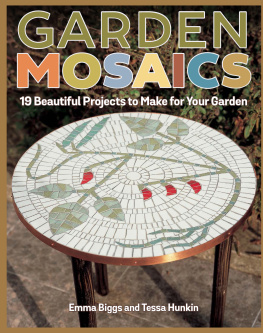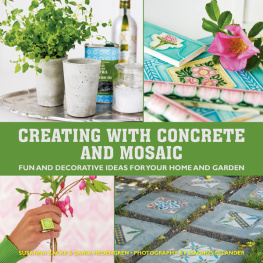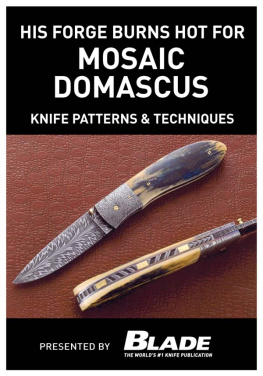The Magic Mesh
Mosaic MeshProjects
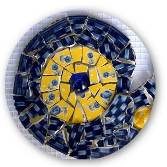
Sigalit Eshet
Copyright 2014 Sigalit Eshet
Smashwords Edition, LicenseNotes
This ebook is licensed for yourpersonal enjoyment only. This ebook may not be re-sold or givenaway to other people. If you would like to share this book withanother person, please purchase an additional copy for eachrecipient. If youre reading this book and did not purchase it, orit was not purchased for your use only, then please return toSmashwords.com and purchase your own copy. Thank you for respectingthe hard work of this author.
Table ofContents:
INTRODUCTION
There are many methods for making mosaics.After learning some, you can choose the most appropriate way foryou. The mosaic art combine different materials, shapes, cuttingstyles, designs, and bases.
In this book, which is the sixth in a seriesof my mosaic books, I decided to focus on mosaic meshprojects.
Why Mesh?
Lately, I have noticed that my students reallylove working on mesh. They decorate their house walls this way,especially outside walls. The results are beautiful and colorful. Idecided to share my knowledge with you. In this book, you will findmany examples of mosaic mesh work that you can use to decorate yourhouse walls - inside or outside.
One of the uses of the mesh is as a secondarypreparation station, when the original preparation location for themosaic work is too far from the installation area. The flexibilityof the mesh allows us to make the mosaic work at home or in thestudio, then we can easily pack (also in separate parts) it up andstick it in the appropriate place. The mesh is easy to cut so youcan create different forms of mosaic art work, not just straight,like cutout. Much easier than cutting a complex shape in boards,with a saw.
Here are some examples of mosaic works thatinclude mesh as a base:
- Stairs
- Name, letters, and house numbers
- Uneven shapes
- Bathroom tiles
- Pictures you want to copy (and put behindthe mesh)
- A big wall image that is divided intoparts
- Joint Group working
In this book we will learn two techniques ofmosaic on mesh. The first one is sticking pieces directly on themesh, and the second is a mesh base that we will make.
The difference between the two methods is thetype of glue used and in the grout making.
My name is Sigalit Eshet. I'm a mosaic artist,and I have taught mosaics for several years. Inmy studio, I create and teach mosaic and believe that any personcan find a way to express him or herself throughit . I studied Art and teaching Art inUniversity, and I have worked as a graphic designer for many years.I have specialized in many different fields of art over theyears , and I combine all my experience tocreate my mosaic work.
When making mosaic wall picture, the mesh workis very suitable for use with broken plates or cups. Later in thisbook you will see many examples. This is the time to collect allthe unused or broken dishes you have, search in flea markets forspecial and colorful plates that you can break, tell all yourneighbors to gather some for you ... and start your mosaic meshwork.
At the end of the book there is a bonus foryou. All the patterns that are showed, in this book, are availablein a pdf file, for your use.
Be creative and use yourimagination,
Sigalit Eshet
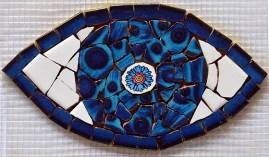
MOSAIC MATERIALS
When you make a mosaic mesh work, thematerials can be varied and depend on the type of work you aremaking.
If it's any wall picture, you can mixdifferent types of materials with different heights. When combiningtiles with glasses and plates, beads and found objects in one work,the mosaic work is much more interesting and rich.
If you make a floor mat, for example, it isvery important that the surface will be smooth and therefore youshould use tiles with the same height.
Mosaic materials are varied andinclude:
Colorful ceramic tiles You can findthem in different shapes and sizes.
Glass tiles These come in uniformsize squares and in many colors. They have one smooth flat side(which should face up), and a rough side (face down; this is theside to which glue is applied).
Stained glass You can get this inmany colors and textures. You can cut it with a nipper or a glasscutter.
Ceramic square tiles These areavailable in many colors, textures, and shapes. They come mostly ona square mesh.
China and crockery Using propersafety precautions, these can be broken or used to cut your owntiles from. Something you get from plates is the unique texturethat you can't find in tiles.
Found objects These include: beads,seashells, glass beads, buttons, glass nuggets, necklaces, or brooch es. Useit to decorate and enrich your work.
Mirrors These can add a beautifulreflective touch to any mosaic piece.
Polymer clay Use polymer clay, likeFimo, to decorate your mosaic work.
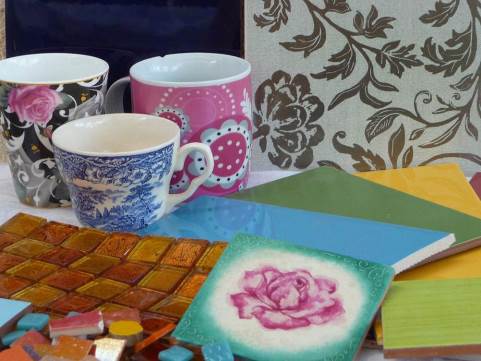
MOSAICTOOLS AND EQUIPMENT
Basic mosaic tools are inexpensive and easilyattainable (in the list below I also included some materials foradvanced use):
Safety equipment:
Safety goggles to protect your eyesfrom ceramic fragments. Use it when you cut the ceramic.
Dust mask use this when making thegrout.
Preparation tools
Pencil for drawing the desiredpattern on the substrate material.
Ruler to mark straightlines.
Latex gloves to protect your handsfrom scratches and dirt.
Rubber gloves put these on before youstart working with grout.
Plastic tools for grout mixing, tilecollecting and gluing.
Small brush for cleaning the surfacefrom dust and small particles.
Thin screwdriver for cleaning tileadhesive residue.
Tweezers for the placement of smallparts.
Paintbrush for adhesiveapplication.
Wooden mixing sticks for mixing groutand applying the tile adhesive.
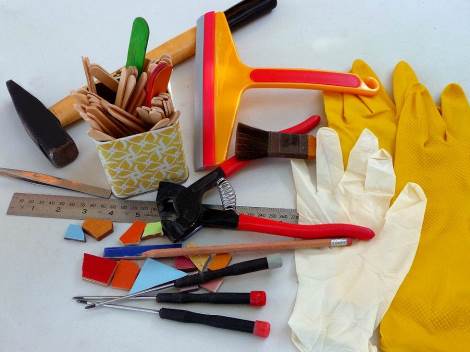
CUTTING TOOLS
Mosaic tile cutter for cutting and grinding ceramictiles. You can get these in hardware stores.
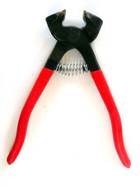
Using the mosaic cutter
1. Before cutting put Safety goggles toprotect your eyes from small fragments.
2. Hold the bottom of the cutter with yourdominant hand with the curved side facing toward the ceramics. Holdthe ceramic tile in your non-dominant hand, and in your dominanthand, hold the bottom of the cutter handle.
3. Hold the ceramic tile with the cutter in astraight or diagonal direction to suit the type of crop you want,and clip!
Tip: If it's your first time, startwith cutting soft ceramic tiles for easy use. In time, you can tryto cut different kinds of tiles.
Next page




